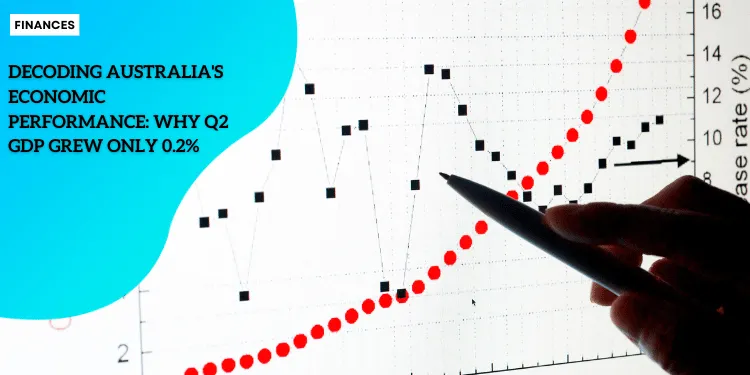Decoding Australia’s Economic Performance: Why Q2 GDP Grew Only 0.2%

Anúncios
Australia’s economic performance in the second quarter of 2023 exhibited modest growth.
The country’s GDP grew by 0.2% compared to the previous quarter, a figure that fell short of FactSet economists’ projection of 0.3%.
Anúncios
Despite this slight shortfall in quarterly growth, the annual GDP growth rate was aligned with expectations, reaching 1% between April and June.
This outcome, although not spectacular, underscores a steady trajectory amid varying economic conditions.
Anúncios
The Australian Bureau of Statistics (ABS) reported these figures, which serve as a crucial benchmark for assessing the nation’s economic health.
While a slight deviation from predictions can cast a temporary shadow, the broader picture reveals resilience and stability within the Australian economy.
This consistency in annual growth points to an underlying fortitude, enabling the country to maintain a balanced economic progression.
Understanding these dynamics is essential for evaluating Australia’s economic performance.
This quarterly shortfall, while noteworthy, does not detract from the annual growth that matches economists’ projections.
The focus now shifts to the underlying factors influencing these results and their implications for future economic strategies.
By contextualizing these figures within a broader time frame, one can glean deeper insights into the complexities of economic trends, aiding in crafting informed economic policies and projections.
Analyzing the key indicators driving these outcomes will further elucidate potential avenues for bolstering growth.
Analyzing the Quarterly Growth Rate
Examination of the 0.2% Quarterly Growth
Australia’s Q2 GDP growth rate of 0.2% was modest, falling short of the economists’ predicted 0.3%.
This growth reflects a slow pace compared to previous quarters, indicating that the economy faced some headwinds.
The Australian Bureau of Statistics reported these figures, shedding light on the underlying trends within the economy.
Comparison to Previous Quarters’ Performance
When we compare Q2 performance to previous quarters, the slower growth becomes evident.
For instance, Q1 2023 saw a slightly higher percentage gain, suggesting a deceleration in economic activities.
This trend is concerning but not entirely unexpected given the global economic environment, characterized by persistent inflation and supply chain disruptions.
Factors Contributing to the Lower-Than-Expected Growth
Several factors contributed to the subdued Q2 growth.
- Domestic Challenges: High inflation and increased cost of living reduced consumer spending. When households tighten their belts, businesses also feel the pinch as reduced demand affects their revenue.
- Interest Rates: The Reserve Bank of Australia’s interest rate hikes aimed at curbing inflation have had a dampening effect on borrowing and spending.
- Global Influences: Ongoing geopolitical tensions, particularly the impact of the Russia-Ukraine conflict, have strained global supply chains, affecting trade and investment.
Despite falling slightly below expectations, this performance hints at underlying resilience within the Australian economy, supported by strong annual growth figures.
This backdrop sets the stage for examining the broader annual trends and their implications for economic stability.
Annual GDP Growth Perspective
Australia’s annual GDP growth registered at 1% from April to June, aligning perfectly with economists’ expectations.
This alignment underscores a broader and more stable economic progression despite the quarterly shortfall observed in Q2 2023.
Aligning with Projections
The annual growth rate meeting economists’ projections is noteworthy.
Predictions often incorporate a range of variables including consumer spending, business investment, and external trade conditions.
Even as some indicators experienced variability, the accurate prediction of a 1% growth signals a predictable and somewhat resilient economic environment.
Implications for Economic Stability
Several factors contribute to interpreting this 1% growth as a sign of economic stability.
Firstly, it reflects the country’s capacity to navigate internal challenges such as fluctuating interest rates and cost-of-living pressures.
Furthermore, it demonstrates an underlying robustness amidst global uncertainties like the Russia-Ukraine conflict and its accompanying economic ripple effects.
While the quarterly performance did not hit its target, the annual growth provides a cushion, indicating that Australia’s economy is not veering off course.
This stability is crucial for policymakers and investors who rely on consistent growth trends to make informed decisions about future investments and economic strategies.
Looking at annual growth also helps in setting realistic future expectations.
While immediate quarter numbers can fluctuate, yearly data offers a more balanced overview of economic health.
Australia’s 1% annual growth suggests that while the economy may face headwinds, its foundational strength remains intact.
As we move forward, the focus isn’t just on quarterly hiccups but understanding deeper, long-term economic trajectories.
Economic Indicators and Their Impact
Analysis of Key Economic Indicators
Australia’s GDP growth of 0.2% in Q2 2023, though modest, reflects the culmination of various economic indicators.
These indicators offer insight into both the domestic and international factors at play.
Domestic Factors
Key domestic factors include consumer spending, business investments, and government policies.
Consumer spending, a primary driver of GDP, faced constraints due to rising interest rates aimed at controlling inflation.
This cautious spending reduced overall economic activity.
Business investments also showed sluggishness as companies adopted a wait-and-see approach, uncertain about the future economic landscape.
Another domestic factor is household debt levels. High debt burdens on households often lead to decreased spending, which in turn impacts GDP.
Despite these challenges, government policies, such as stimulus packages and infrastructure investments, provided some economic stability.
International Factors
Internationally, Australia’s GDP was influenced by global market trends, trade relationships, and geopolitical events.
For example, the ongoing Russia-Ukraine conflict has led to fluctuating commodity prices, affecting Australia’s export revenues, particularly in mining and agriculture.
Additionally, global supply chain disruptions have posed significant challenges for Australian producers and consumers alike.
Partnerships with key trading partners like China and the United States also play a crucial role.
Positive economic trends in these countries can boost Australian exports, while downturns can have the opposite effect.
Potential Areas of Economic Strength and Weakness
Strengths
- Natural Resources: Australia’s abundant natural resources, such as iron ore and coal, continue to be a major economic strength. High global demand for these commodities contributes positively to GDP.
- Education and Healthcare: The robust education sector and healthcare services also provide a steady income stream. These sectors are less volatile and offer more consistent growth.
Weaknesses
- Dependence on Exports: Heavy reliance on exports makes the economy vulnerable to global market swings. Any downturns in the global economy, like those caused by geopolitical tensions, can significantly impact GDP.
- Housing Market: The housing market remains a double-edged sword. While it can drive growth, current high property prices and associated debt levels pose risks of economic instability.
Understanding these economic indicators and their impacts is vital for crafting informed policies and business strategies. The quarter’s performance, though below expectations, provides valuable insights into the broader economic context.
Global Context and Comparisons
Australia’s economic performance won’t be seen in isolation, especially when considering the global stage.
The modest GDP growth of just 0.2% in Q2 2023 contrasts with the more robust projections made by FactSet economists.
To understand the bigger picture, one needs to look beyond Australia’s borders.
Australia’s Standing Among Developed Economies
Australia’s 1% annual GDP growth places it in an interesting position among other developed economies.
Nations like the United States, Germany, and Japan have shown varied economic strides, often influenced by different factors such as technological advancements, internal policies, and varying degrees of exposure to global conflicts, like the ongoing Russia-Ukraine crisis.
Compared to Europe’s slower growth, largely due to high energy prices and geopolitical instability, Australia’s increase signals resilient, albeit sluggish progress.
Key International Factors Affecting Australia
International economic conditions have a critical impact on Australia.
The global rise in interest rates aimed at curbing inflation has led to cautious consumer spending.
Sluggish investments in various business sectors due to global inconsistencies in supply chain management as well as the international energy market fluctuations add to the complexities.
The Ripple Effects of Global Challenges
Additionally, Australia’s dependency on exports, particularly minerals and energy resources, makes it vulnerable to global market volatilities.
Export demand fluctuations directly impact GDP growth.
In contrast, Australia’s robust healthcare and education systems have been strengths in retaining economic stability in these turbulent times.
Despite these challenges, Australia’s economic strategies and natural resource abundance continue to provide a foundation for navigating global uncertainties.
As we delve deeper into understanding these dynamics, it sets the stage for examining future growth prospects and potential policy responses for further economic stimulation.
Future Outlook and Projections
Expectations for Future Quarters
Given the modest 0.2% GDP growth in Q2 2023, Australia’s economic outlook for the coming quarters hinges on a mix of cautious optimism and calculated policy interventions.
Economic analysts suggest that future performance will rely heavily on the global economic landscape, domestic consumption patterns, and ongoing strides in key sectors such as healthcare, education, and technology.
The anticipated gradual easing of global supply chain disruptions and inflation could potentially provide a more stable environment for growth.
Potential Policy Responses to Stimulate Growth
To navigate these uncertain waters, the Australian government could consider several policy measures:
- Fiscal Stimulus: Injecting funds into infrastructure projects and social programs could stimulate job creation and spending.
- Monetary Policy: Fine-tuning interest rates to maintain a balance between spurring growth and controlling inflation will be crucial.
- Sectoral Support: Targeted support for high-potential sectors like renewable energy, healthcare, and IT can drive sustainable growth.
Implementing these policies could buffer the economy against external shocks and foster a more resilient economic structure.
Long-term Implications for Australia’s Economic Trajectory
In the long run, Australia’s economic trajectory depends on how effectively it adapts to both domestic and international challenges.
A sustained policy focus on diversified growth can mitigate risks associated with its export-dependent economy.
Strengthening domestic industries and enhancing trade partnerships will be critical.
Australia’s ability to address structural weaknesses, such as housing market instability and reliance on commodity exports, will shape its economic resilience.
If managed well, these initiatives could position Australia favorably on the global stage, contributing to robust and inclusive economic growth.






